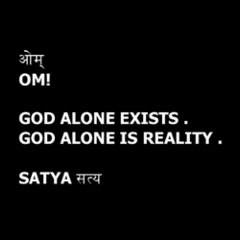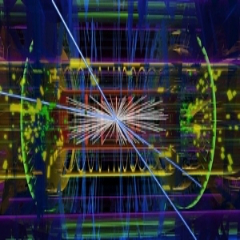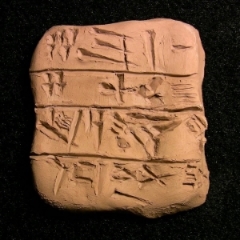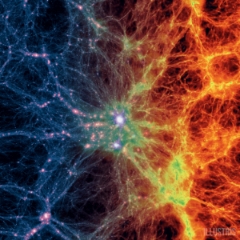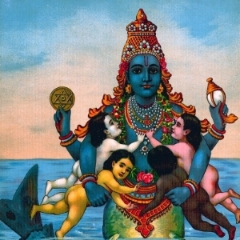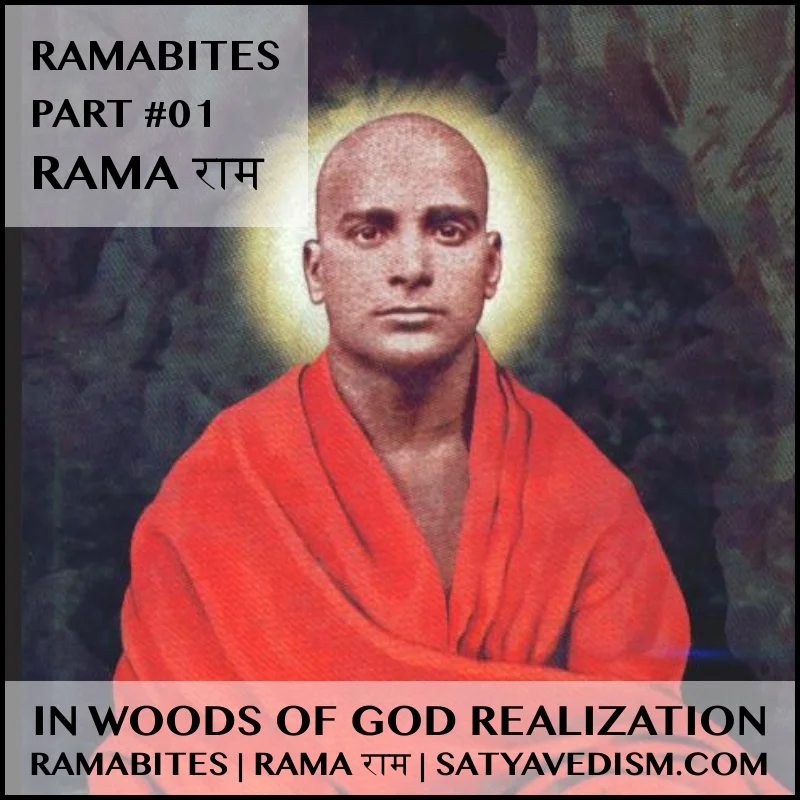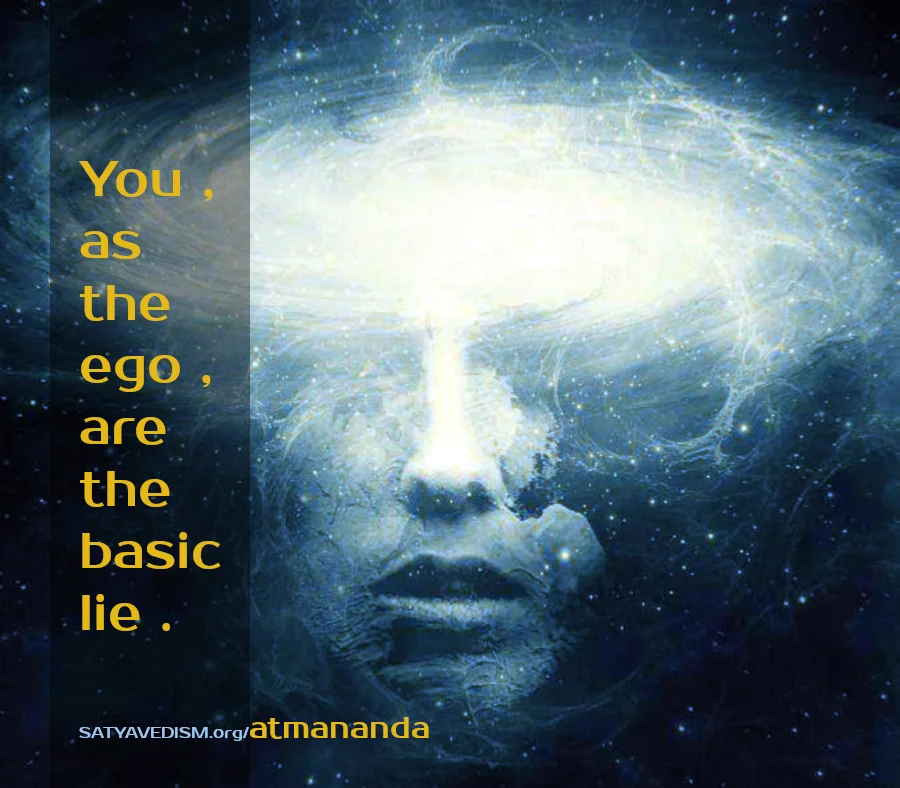BRHADARANYAKA UPANISAD | 2.3.6 | AMOETD
| | homeBRHADARANYAKA UPANISAD | 2.3.6 | SRI SANKARACARYA
tasya haitasya purusasya rupam yatha maharajanam vasah , yatha pandv-avikam , yathendragopah , yathagnyarcih , yatha pundarikam , yatha sakrd-vidyuttam ; sakrd-vidyutteva ha va asya srir bhavati , ya evam veda . athata adesah na iti na iti , na hy etasmad iti , na ity anyat param asti ; atha nama-dheyam satyasya satyam iti . prana vai satyam , tesam esa satyam . || 2.3.6 ||
6 . The form of that " being " is as follows : Like a cloth dyed with turmeric , or like grey sheep's wool , or like the ( scarlet ) insect called Indragopa , or like a tongue of fire , or like a white lotus , or like a flash of lightning . One who knows it as such attains splendour like a flash of lightning . Now therefore the description ( of Brahman ) : " Not this , not this " . Because there is no other and more appropriate description than this " Not this " . Now Its name : " The Truth of truth " . The vital force is truth , and It is the Truth of that .
|| BHASYA || : The division of the gross and subtle , called truth , which are the limiting adjuncts of Brahman , into what relates to the gods and what relates to the body , in their twofold division of the body and organs , has been explained .
Now we ( the scriptures ) shall describe the form of that " being " identified with the organs , ie the subtle body . It consists of impressions , and is produced by the union of the individual self and the impressions of gross and subtle objects ; it is variegated * like pictures on a canvas or wall , is comparable to an illusion , or magic , or a mirage , and is puzzling to all .
For instance , the Buddhistic Idealists ( Yogacaras ) are mistaken into thinking that the self is this much only . The Naiyayikas and Vaisesikas , on the other hand , maintain that like the colour of a cloth , these impressions are the attributes of the self , which is a substance . While the Samkhyas hold that the mind , which is dependent on the Prakrti * and is possessed of three tendencies , is a separate entity , subserves the purpose of the self , and operates for its highest good ( liberation through experience ) .
Some self-styled followers * of the Upanisads too spin out the following theory :
The gross and subtle elements make one ( the lowest ) entity , the Supreme Self is the highest entity , and different from and intermediate between these two is the third entity , which it the sum total of one's meditations , actions and previous experience , together with the individual self which is the agent and experience , the one that Ajatasatru awoke . The actions etc are the cause , and the gross and subtle elements mentioned above as also the body and organs , which are the means of meditations and actions , are the effect .
They also establish a connection with the logicians by stating that the actions etc abide in the subtle body . Then they are frightened lest this should smack of Samkhya , and conform also to the Vaisesika view by saying that just as odour , which abides in flowers , can be conserved in oil through boiling , even when the flowers are gone , so even when the subtle body is gone , all actions etc are conserved in a portion of the Supreme Self . That portion , although transcendent , becomes conditioned through attributes — the actions etc — coming from elsewhere * . This individual self then becomes the agent and experiencer , and is subject to bondage and liberation . Those actions etc are but adventitious things , coming from the elements ; the individual self , being a portion of the Supreme Self , is in itself transcendent . Ignorance , which springs from the Self , although natural to It , is not an attribute of the Self , just as a desert does not affect the whole earth . Through this statement they conform also to the Samkhya view .
They look upon all this as excellent because of its harmonising with the logicians' view , but they do not see that it contradicts the verdict of the Upanisads as well as all reasoning . How ? For instance , we have already said that if the Supreme Self be composed of parts ( and the individual self be identical with It ) , that view would be open to various objections , such as the Supreme Self being subject to transmigration and having wounds , besides the impossibility of Its going after death to places in accordance with Its past work .
While if the individual self be eternally different from the Supreme Self , it can never be identical with It . If it is urged that the subtle body itself is figuratively referred to as part of the Supreme Self , like the ether enclosed in a jar , a bowl , the pores of the earth , etc , then it is impossible to maintain that even when the subtle body * has ceased to be ( as in the state of profound sleep ) , impressions persist in a part of the Supreme Self , or that ignorance springs from It , as a desert does from the earth , and so on .
Nor can we even mentally imagine that impressions move from one thing to another without the help of some object in which they can inhere . Nor would such Sruti passages as , " Desire , resolution , doubt ( etc are but the mind ) " ( I . v . 3 ) , " It is on the heart ( mind ) that colours rest " ( III . ix . 20 ) . " It thinks , as it were , and shakes , as it were " ( IV . iii . 7 ) , " All desires that are in one's heart " ( IV . iv . 7 ; Ka . VI . 14 ) , and " One is then beyond all the woes of one's heart " ( IV . iii . 22 )‚ fit in with such a view .
And it is not proper to explain these passages otherwise than literally , for they are meant to show that the individual self is no other than the Supreme Brahman . And all the Upanisads end by giving out this sole meaning .
Therefore persons skilled only in fancifully interpreting the Srutis all distort their meaning . Yet , if those interpretations are in consonance with the teaching of the Vedas , they are welcome ; we have no grudge against them .
Moreover , the expression , " Brahman has but two forms " , does not agree with the view that posits three entities . If , however , the gross and subtle forms together with the impressions respectively springing from them constitute two forms , gross and subtle , while Brahman is a third entity possessed of those two forms , and there is no fourth entity in between , then only is the assertion , " Brahman has but two forms " , congruous .
Otherwise we have to imagine that the individual self is a part of Brahman , and has the two forms ; or that the Supreme Self , through the medium of the individual self , has them . In that case the use of the dual number , indicating only " two forms " , would be inconsistent . The plural , denoting " many forms " , including the impressions , would be more appropriate — the gross and subtle forms being two , and the impressions being a third entity .
If it be maintained that the gross and subtle forms alone are the forms of the Supreme Self , but the impressions belong to the individual self , then the form of expression used , viz that " the Supreme Self , which undergoes modification through the medium of the individual self , ( has the forms ) " , would be meaningless , since impressions too would equally affect the Supreme Self through the medium of the individual self . But we cannot at all imagine , except in a figurative sense , that a thing undergoes modification through the medium of something else . Nor is the individual self something different from the Supreme Self .
To admit this is to contradict one's own premise . Therefore this sort of interpretation has its origin only in the imagination of those who are ignorant of the meaning of the Vedas , and is not warranted by the text . An interpretation of the Vedas that is not so warranted cannot be regarded either as a true interpretation or as helping towards it , for the Vedas do not derive their authority from any other source . Therefore the view that three entities are in question is untenable .
The subtle body has been introduced in connection with matters relating to the body in the clause , " The being that is in the right eye " ( II . iii . 5 ) , and in connection with those relating to the gods in the clause , " The being that is in the sun " ( II . iii . 3 ) . The word " that " ( in the expression , " The form of that being " ) refers to something that is being discussed , in other words , that which is the essence of the subtle , undefined , but not the individual self .
OBJECTION : Why should not these forms belong to the individual self , since it too has a place in the discussion , and the word " that " refers to something that is under discussion ?
REPLY : No , for the Sruti wants to teach the transcendent nature of the individual self . If the forms , " Like a cloth dyed with turmeric " , etc ( II . iii . 6 ) , really belong to the individual self , then it would not be described as indefinable in the terms , " Not this , not this " .
OBJECTION : Suppose we say this is a description of something else , and not of the individual self .
REPLY : Not so , for at the end of the fourth chapter ( IV . v . 15 ) , referring to the individual self * in the words , " Through what , O Maitreyi , should one know the Knower ? " ( IV . v . 15 ) , it is concluded: ' This self is That which has been described as " Not this , not this " ' . Besides , thus only can the statement , " I will instruct you ( about Brahman ) " , be relevant . That is to say , if the Sruti wants to teach the transcendent nature of the individual self — which is free from all differentiations of limiting adjuncts , then only can this assertion be fulfilled .
Because , instructed in this way , the student knows oneself to be Brahman , thoroughly understands the import of the scriptures , and is afraid of nothing .
If , on the other hand , the individual self is one , and what is described as " Not this , not this " is something else , then the student would understand just the reverse of truth , viz that Brahman is something , and that one is something else . One would not ' Know only oneself as , " I am Brahman " ' ( I . iv . 10 ) . Therefore the forms given in the passage , '"Now the form of that being " , etc are only those of the subtle body .
Besides , in order to tell the nature of the Supreme Self , which is the Truth of truth , the latter must be told in its entirety . And impressions being the particular forms of that truth , these forms of the impressions are being mentioned . These are the forms of this being , ie of the subtle body that is being discussed . What are they ?
As in life we have a cloth dyed with turmeric , so in the presence of objects of enjoyment the mind gets a similar colouring of impressions , whence a person under such circumstances is said to be attached , as a cloth , for instance , is dyed .
Also as sheep's wool is grey , so are some other forms of impressions .
Again , as in the world the insect called Indragopa is deep red , so also are some impressions of the mind .
The colouring varies sometimes according to the objects presented to the mind , and sometimes according to the tendencies of the mind itself .
As , again , a tongue of fire is bright , so are some people's impressions at times .
Like a white lotus too are the impressions of some .
As in nature a single flash of lightning illumines everything so according to the intensity of the manifestation of knowledge , do the impressions of some people .
It is impossible to ascertain the beginning , middle or end , or number , place , time and circumstances of these impressions , for they are innumerable , and infinite are their causes . So it will be said in the fourth chapter , " ( This self is ) identified with this ( what is perceived ) and with that ( what is inferred ) " , etc ( IV . iv . 5 ) .
Therefore the examples given in the passage , " Like a cloth dyed with turmeric " etc are not meant to indicate the exact number of the varieties of impressions , but merely to suggest their types , meaning that impressions are like these . The form of impression that has been cited at the end , viz " Like a flash of lightning " refers to the sudden manifestation of everythiing like lightning , as Hiranyagarbha emanates from the Undifferentiated * .
One who knows that particular form of impression belonging to Hiranyagarbha , attains splendour like a flash of lightning . The particles " ha " and " vai " are for emphasis . Just like this , ie like that of Hiranyagarbha , becomes the splendour or fame of one who knows it , the form of impression last mentioned , as such , as described above .
Having thus completely described the nature of " truth " , the Sruti , in order to ascertain the nature of what has been called " the Truth of truth " , viz Brahman , introduces this text : Now therefore — since after ascertaining the nature of " truth " , what remains is the Truth of truth , therefore the nature of that will be next ascertained .
Description is a specific statement — about Brahman . What is this statement ? " Not this , not this " .
How through these two terms " Not this , not this " is it sought to describe the Truth of truth ? By the elimination of all differences due to limiting adjuncts , the words refer to something that has no distinguishing mark such as name , or form , or action , or heterogeneity , or species , or qualities . Words denote things through one or other of these .
But Brahman has none of these distinguishing marks . Hence It cannot be described as , " It is such and such " , as we can describe a cow by saying , " There moves a white cow with horns . " Brahman is described by means of name , form and action superimposed on It , in such terms as , " Knowledge , Bliss , Brahman " ( III IX . 28 ) , and " Pure Intelligence " ( II . iv . 12 ) , " Brahman " and " Atman " .
When , however , we wish to describe Its true nature , free from all differences due to limiting adjuncts , then it is an utter impossibility . Then there is only one way left , viz to describe It as " Not this , not this " , by eliminating all possible specifications of It that have been known .
These two negative particles are for conveying all-inclusiveness through repetition so as to eliminate every specification whatsoever that may occur to us . Such being the case , the doubt that Brahman has not been described is removed .
If , on the other hand , the two negative particles merely eliminated just the two aspects of Brahman that are being discussed ( viz the gross and subtle ) , then other aspects of It besides these two would not be described , and there would still be a doubt as to what exactly Brahman is like . So that description of Brahman would be useless , for it would not satisfy one's desire to know It .
And the purpose of the sentence , " I will instruct you about Brahman " ( II . i . 15 ) , would remain unfulfilled . But when through the elimination of all limiting adjuncts the desire to know about space , time and everything else ( that is not Brahman ) is removed , one realises one's identity with Brahman , the Truth of truth , which is homogeneous like a lump of salt , is Pure Intelligence , and is without interior or exterior ; one's desire to know is completely satisfied , and one's intellect is centred in the Self alone .
Therefore the two negative particles in " Not this , not this " are used in an all-inclusive sense .
OBJECTION : Well , after buckling to with such ado is it fair to describe Brahman thus ?
REPLY : Yes . Why ? Because there is no other and more appropriate description than this " Not this , not this " , therefore this is the only description of Brahman .
The particle " iti " , repeated twice , covers all possible predications that are to be eliminated by the two negative particles , as when we say , " Every village is beautiful . "
It was said , " Its secret name is : The Truth of truth " ( II . i . 20 ) ; it is thus that the Supreme Brahman is the Truth of truth . Therefore the name of Brahman that has been mentioned is appropriate . What is it ? The Truth of truth . The vital force is truth , and It is the Truth of that .
( Notes : * All this indicates that it is the mind that is being described , and not the self . | * The primordial material out of which the universe has been formed . | * A hit at Bhartrprapanca | * The elements forming the body and organs . | * Which is the repository of impressions . | * In its unconditioned aspect as the Witness | * The principle representing the unmanifested state of the universe . )
|| UPADESA SAHASRI : A METHOD OF ENLIGHTENING THE DISCIPLE || I.I.6 || COMPLETE AMOETD SERIES ➤➤ | INTRODUCTION ➤➤ | & http://bit.ly/1dzDT6J ||
|| THIS SCRIPTURE SERIES SOURCE || ➤
|| 1 || http://www.SATYAVEDISM.com ||
|| 2 || http://bit.ly/SRIADISHANKARA ||
http://www.SATYAVEDISM.com/shankara/amoetd/
SOURCE | SATYAVEDISM.ORG











